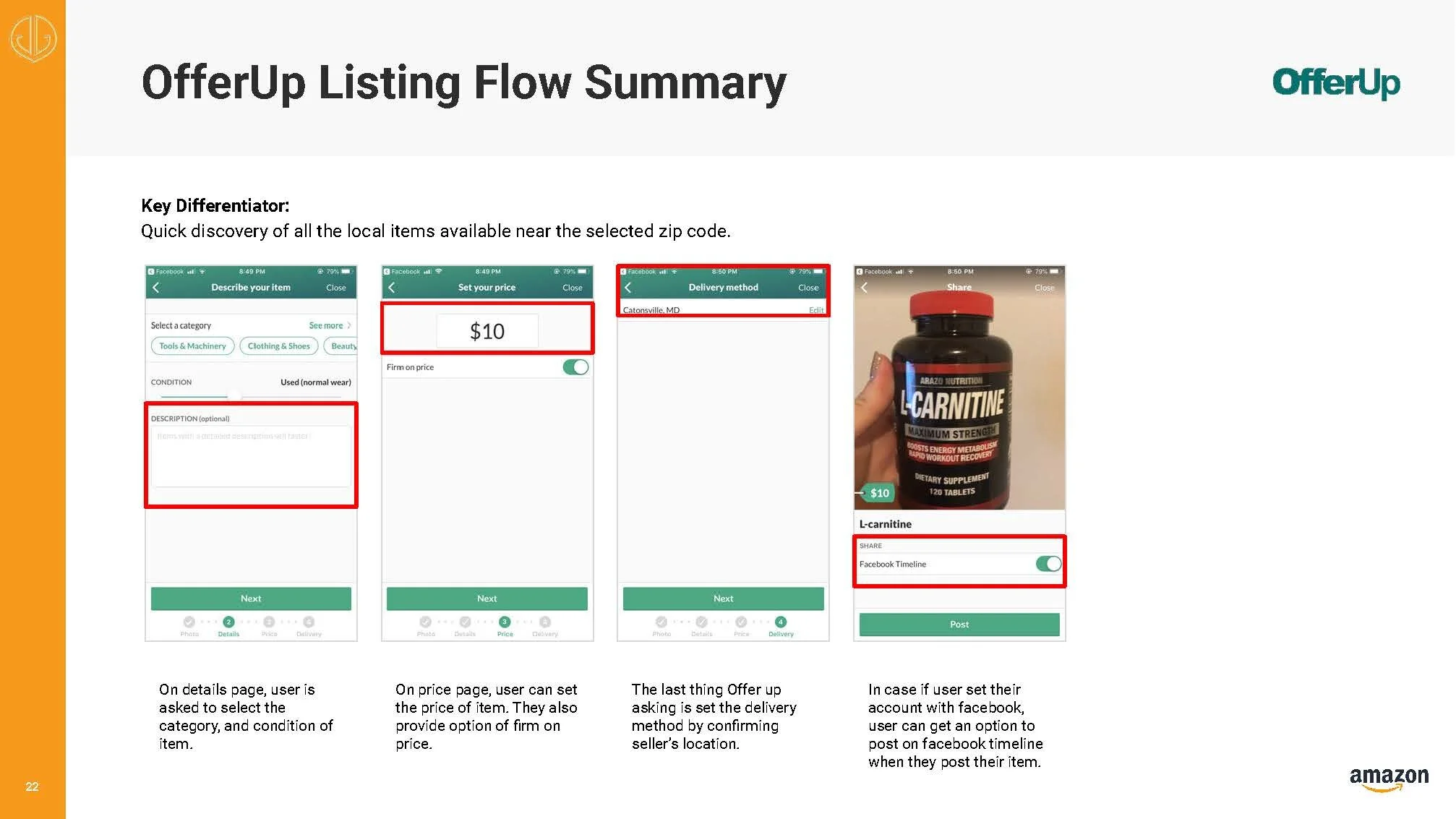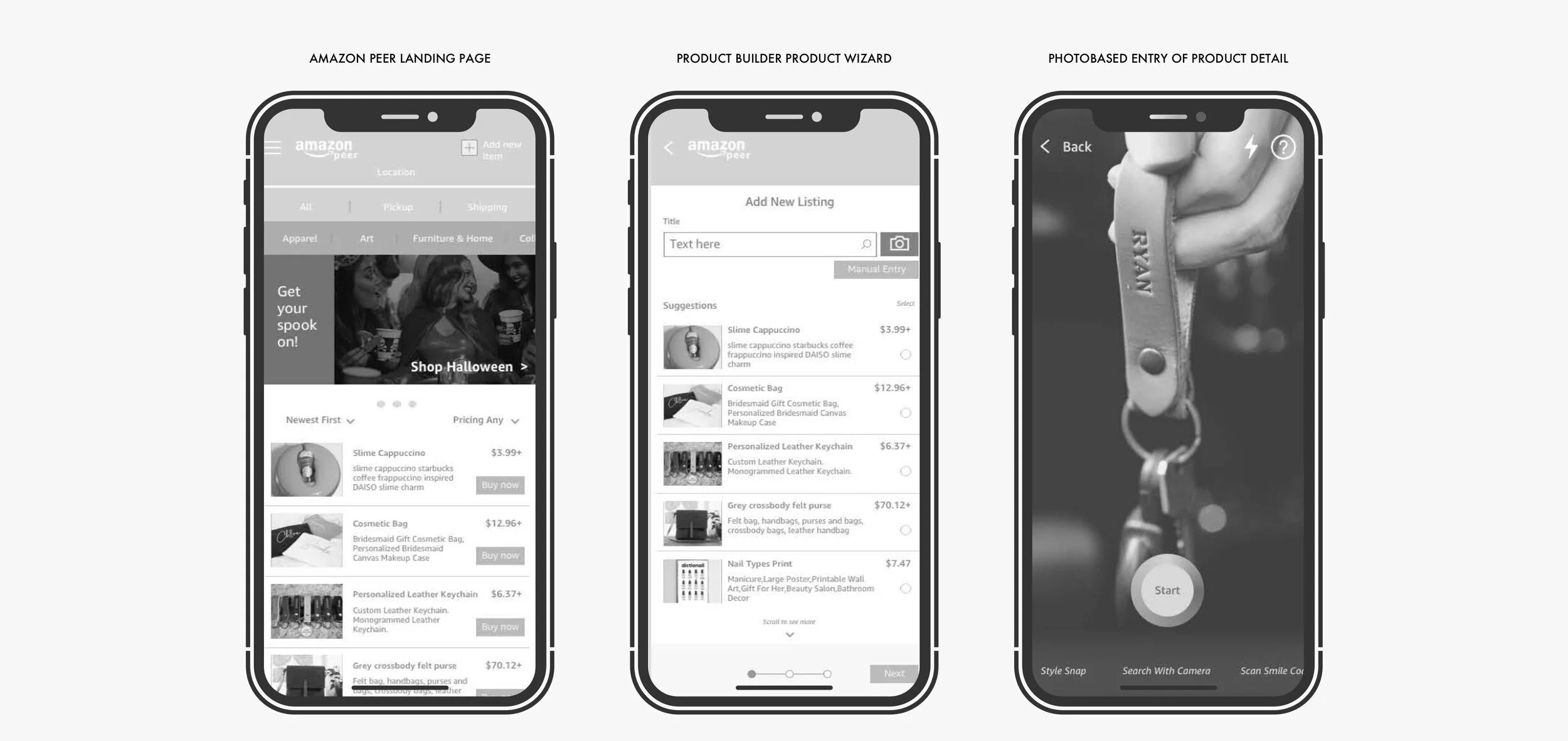Amazon peer: a new c2C marketplace
Project Background:
Amazon offered a UX challenge to employees to generate business white spaces within the marquee product. They asked for teams and individuals to deliver discovery findings of its competitive landscape and make recommendations of innovation opportunities for its mobile e-commerce platform. This ask was explored in two phases over 12-weeks.
Amazon is recognized as a global market leader in the online retail space. There is a unique opportunity for Amazon to facilitate an acutely personalized, relevant and friendly shopping experience that is both convenient and cost effective for individual buyers and corporations.
The Opportunity:
Our team researched two user segments including frequent online shoppers (who are also the account owners), as well as business retail stakeholders that act as decision makers for their respective product businesses. As a launching point, we asked questions related to two popular verticals in the marketplace, home goods and apparel.
Analyzing our research, we decided to focus on a segment of avid Amazon shoppers with high-potential to engage as independent sellers, who might be interested in selling second hand goods directly to other consumers.
Design Team:
A team of four UX Designers, I was responsible for user interviews and a google survey, analysis, and collaborated on the prototype and presentation preparation.
The Tools Used:
Desk research of the field, Google based surveys, In-person interviews, UX Pressia, Persona Generator, Sketch, Invision, Powerpoint
Methodology:
During a 6-week discovery phase we investigated Amazon’s target audience through in-person interviews and surveys that considered two segments (e-commerce buyers and sellers). From our analysis, we derived key personas and user profiles. We also documented in-depth competitive analysis along with a heuristic audit of the current app. During the second 6-week phase, we developed user stories that led to an MVP based on our hypotheses. Prototyping in three rounds, we validated through user-testing.
The Final Outcome:
The key takeaway is that Amazon is a best-in-class B2C ecommerce company, but it has room to disrupt the C2C marketplace for used, refurbished and small-run goods sold from individual users/non-business entities. Buyers want more relevant and unique search results intuitively personalized to their needs with fewer clicks and from sources that they trust. Individual sellers want to list their unique and lightly used products with guidance to best-practices and in the fewest clicks possible. Amazon is uniquely trusted by buyers and the sellers who recognize Amazon as an integral marketplace to reaching their target audience.
For next steps, we would continue to expand the features of the high-fidelity prototype and identify core traffic vehicles toward a beta test deployment with a limited customer segment.
Artifacts
Personas
We interviewed 6 people who fit our target profiles and also gained insights from 15 participants that responded to a google-based survey.
All online buyers shop for themselves.
All online sellers are also buyers.
85% of buyers prefer shopping online to shopping in-stores.
Buyers are interested in selling but intimidated/unfamiliar with the process.
Most important value propositions for shoppers:
Convenience of online shopping, consistent quality, variety of product, discounts, and expedited delivery.
Biggest painpoints for shoppers:
Not being able to physically interact with the product, issues with delivery, and limited inventory.
Sellers feel insufficiently supported from Amazon B2B and AWS customer services to display their products.
Design and technical support support could lead to greater adoption.
Amazon’s Competitive Landscape
Key themes that matter to the target audience.
Trustworthy vending: Customer reviews showed that the beyond getting great deals, brands were most successful when they instilled a sense of reliability of product exploration and delivery to the shopper.
Simplified and personalized exploration: On an ‘everything’ platform customers want to have access to all of their product needs in one environment and yet each platform has uncommunicated strengths and weaknesses.
Easy to post products: Vendors and individual sellers frequently are looking for better tools to sell on.
Amazon in the wild
Platform Strengths
Clearly demarcated sections make for a clear visual hierarchy
Image rich environment
User research has validated that the Amazon button conveys the sense of trust and reliability to consumers
Customer’s are prompted to sign-in for a richer experience but have the flexibility to shop anonymously.
Platform Weaknesses
Products in photographs don’t necessarily align with how they look and feel in person
Arriving at a product requires a great deal of digging and primarily requires a lot of filtering.
Theft and delivery management are consistent challenges in the e-commerce industry
Doesn’t offer outlets for those looking to buy and sell on the P2P market.
Retailers recognize that they do not own their data and that Amazon is opportunistic with sellers that use their platform.
Wire flow to post products
Paper Prototype
The mood board provided insights and inspiration from competitive products in the wide for consideration as the Amazon Peer user experience was being designed.
Grayscale Prototype
Stakeholder prototype
Recorded Presentation
Downloadable: PDF Presentation

























































